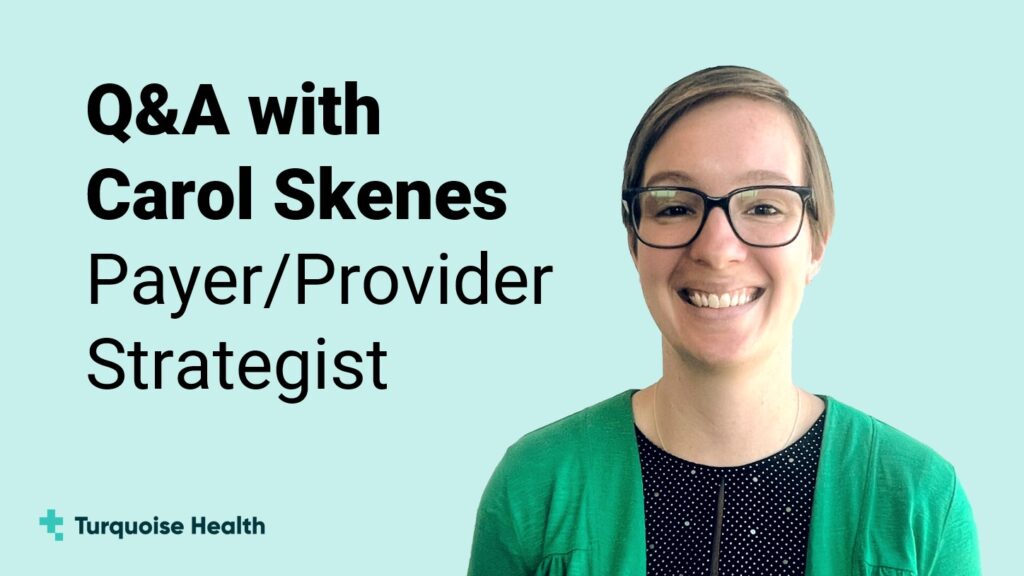Turquoise Health was recently featured in an article on the leading companies in healthcare price transparency. To learn more about the Centers for Medicare and Medicaid Services (CMS) Hospital Price Transparency Rule and the Turquoise approach to making publicly available pricing data meaningful to providers, payers and patients, Xtalks spoke with Carol Skenes, Payer/Provider Strategist at Turquoise Health.
Let’s start by talking about healthcare price transparency – when did patients start shopping around for procedures and what did that look like before price data was so widely available?
Carol Skenes: I think patients have always wanted to know what their cost of care is. Anytime you talk to patients, they say, “I need to have this procedure. I have no idea how much it’s going to cost.” And as those conversations were going on, the percentage of the country’s GDP related to healthcare spending was slowly ticking up, up, up.
In 2019, for the first time there was a pretty significant push at the federal level where “price transparency” meant more than just the broad concept of understanding the cost of care. And this shifted the burden onto hospitals first, and then to insurance companies to post all of their negotiated rates and their self-pay cash prices in what’s referred to as a “machine-readable file.” This allows users to search for specific words, or specific codes, within the file and yield results.
The 2019 Hospital Price Transparency Rule really was the first major step in getting rates to be publicly available. From there, we’ve hit more incremental milestones with these payers. And it was significant because prior to that, all the negotiations that occurred with hospitals and payers happened behind closed doors. No one knew those negotiated rates — not patients, not hospitals down the street, not other insurance companies.
It was all very mysterious, very opaque, and did not lead to much understanding. The veil has been lifted with these final rules, and that has really been the impetus for using data to ultimately help patients understand their cost of care.
How widely can prices vary for a given procedure? And are higher costs associated with better-quality care?
Carol Skenes: Both are good questions, and we have seen a lot of variations. Some of it makes sense in higher cost of living cities versus more rural areas. But we’ve also seen a variation even with facilities located down the street from each other. Some of that could be a competitive pricing advantage, like wanting every patient that needs an MRI to come to your facility and being price competitive in that way.
As far as the quality question, other than, “How much is my healthcare going to cost me?” that is the main question people are asking. You’re now looking towards the future of price transparency, which is to say, can we combine quality data and this newly publicly available price transparency data to help patients find the most cost-effective care, but not at the risk of getting poor-quality clinicians? We’re not there yet, but that was a big driver for getting a lot of this information publicly available in the first place, to ensure that you could make the most well-informed decision possible for your care.
How does Turquoise Health help hospitals and payers comply with CMS’s Hospital Price Transparency Rule?
Carol Skenes: The first thing we like to say, specifically when it comes to compliance, is only the CMS can deem official compliance. We have read through the final rules with a fine-tooth comb and really taken to consolidating all of the data that’s publicly available into one database. It’s not particularly feasible for a patient or a smaller entity that might not have a lot of technical resources to go download every machine-readable file from the 6,000 hospitals, and then every national, regional and local insurance company as well. So, we have taken that upon ourselves to download all of those files and consolidate them into one location.
These payers and providers have done the work of getting their rates available, but they need a resource that allows them to compare themselves to regional competitors, or those focused on treating the same patient population, such as children’s hospitals. Turquoise really stepped in to find a way to consolidate, enhance and make this data useful, for both payers and providers and then ultimately for patients in the industry.
What makes Turquoise Health different compared to other healthcare price transparency listings?
Carol Skenes: We really only see the data as the foundation for what can fundamentally transform the healthcare industry as it relates to cost. When you think about understanding how much your care is going to cost you — let’s say after you’ve gotten an MRI — knowing the negotiated rate between the hospital and the payer is only the first step in the process of determining your care. You may have a high-deductible plan, you might have 10 percent coinsurance, you might have a $20 copay upfront. And that’s where we move into the world of not just having access to that data, but using that data to give patients estimates that are specific to their self-pay plans, or for insured patients, their individual cost-sharing components.
The data is foundational to creating more accurate estimates prior to an episode of care. Stepping back and looking holistically at not just price transparency data as the be-all, end-all, but saying, “Let’s take it one step further,” is really the Turquoise differentiator in this space.
Does Turquoise Health incorporate any quality indicators in their listings right now, or is that something that’s a planned upgrade down the line?
Carol Skenes: We do have some partnerships with other folks in the industry who are on the physician database side, the quality measurement side or even the actuary side. We’re able to enhance our data with their offerings. We’ve done that thus far through partnerships in the industry.
How are organizations working with you to make use of your price data and compare themselves to competitors?
Carol Skenes: A lot of this really ties into being able to answer the question, “Am I being paid at a fair market rate for the services that are being rendered?” So before, that question was kind of a theoretical one that people asked and didn’t have clear answers. We used to see this in the negotiating rooms with payers and providers who were coming with their own rates, having done their number crunching behind the scenes. At that time, they weren’t really willing to show their cards as far as their calculations and what fair market value would be.
Now everything is publicly available, so it eliminates a lot of that back and forth and takes out the question “What is fair market value?” Instead, you can say, “Let’s look at the data which shows us fair market value,” and then move forward accordingly.
Do you think this push to make price data publicly available will drive healthcare costs down overall?
Carol Skenes: You’re asking what all of the government legislators are asking, and all of the patients — what is this all for? Anytime there is better competition, a better understanding of quality and just giving patients a lot more education to understand their cost of care, then they’re going to feel more empowered to make better decisions. And when they’re able to make decisions, all of a sudden having a competitive price point has a lot more weight in this decision-making process.
But it is going to take time. There’s a lot of additional education that needs to happen for patients to understand this information is even available to them. Enforcement from the government is key, as well as shoring up some of the legislation to make it a little bit more streamlined, easier for folks to access the data and to continue to make the data more useful. So yes, healthcare costs should go down, but we are on a journey to get there.












Join or login to leave a comment
JOIN LOGIN